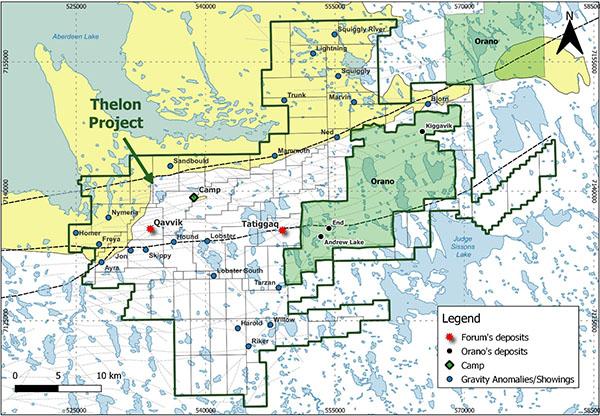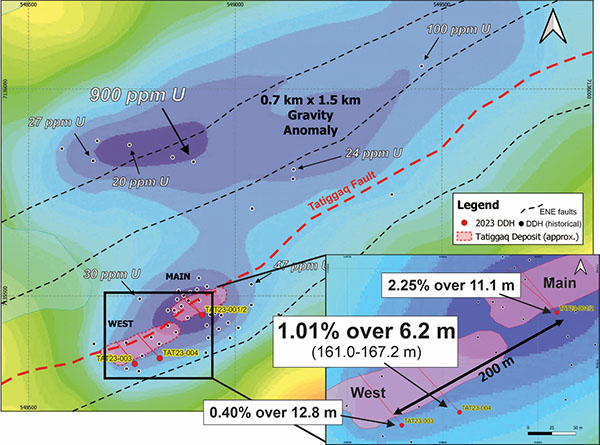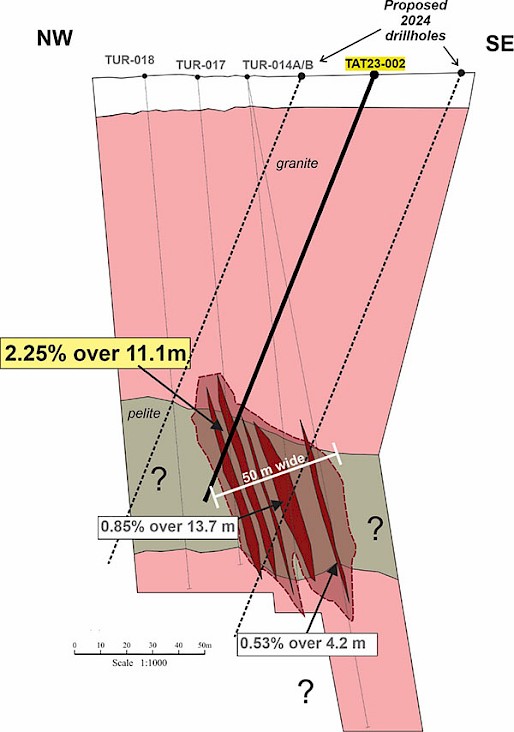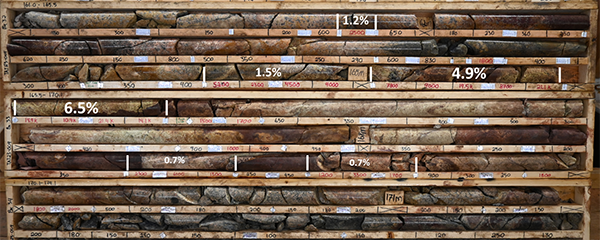Related Document
Vancouver, B.C., October 23, 2023 – Forum Energy Metals Corp. (TSX.V: FMC; OTCQB: FDCFF) (“Forum” or the “Company”) announces additional assay results from its 2023 summer drill program on its Thelon Basin uranium project located 100 km west of Baker Lake, Nunavut. Forum holds a 100% interest in 95,500 hectares of ground adjacent to Orano’s 133 million pound Kiggavik uranium project*. Forum has received results from the last drill hole on the Tatiggaq zone, located five kilometres west of Orano’s 93 million pound Andrew Lake and End uranium deposits (Figure1).
HIGHLIGHTS
- Drilling at Tatiggaq shows continuity of high-grade uranium mineralization along a 250 metre trend with intercepts of 2.25% U3O8 over 11.1 metres, 0.40% over 12.8 metres and now 1.01% U3O8 over 6.2 metres in hole TAT23-004.
- TAT23-004 (West Zone) is located 150 metres southwest of TAT23-002 and 50 metres northeast of TAT23-003 and intersected 1.01% U3O8 over 6.2 m (from 161.0 – 167.2 m) including:
- 0.25% U3O8 over 2.8 m (161.0 – 163.8 m)
- 4.36% U3O8 over 1.3 m (164.6 – 165.9 m)
- Entire mineralized zone in TAT23-004 is 0.40% U3O8 over 18.9 m spanning 151.4 to 170.3 m
Dr. Rebecca Hunter, Forum’s VP, Exploration stated, “Our interpretation from this summer’s drill program at Tatiggaq is that each hole intersected near vertical, high grade lenses of uranium ranging from 18 metres to 24 metres in width over a length of 250 metres. In total, this near surface, structurally controlled deposit is a minimum of 50 metres wide and we have over one kilometre of the anomaly to drill test. In addition, there are multiple sub-parallel trends within the Tatiggaq anomaly that have intersected extreme clay alteration and uranium values up to 900 ppm suggesting that additional mineralization could be present. I am very excited to drill this target in 2024 and build on this exceptional discovery.”
Tatiggaq
Figure 1 shows the main east-northeast structures (Thelon and Judge Sissons faults) as well as the numerous, sub-parallel subsidiary east-northeast structures interpreted to control uranium mineralization on Orano’s and Forum’s property. Figure 2 is a plan map of the Tatiggaq gravity anomaly and drill area. Figure 3 is a cross section of the mineralization intersected in Holes TAT23-001 and TAT23-002 showing the multiple lenses of uranium in the Tatiggaq Main zone.
TAT23-004 was designed to target the Tatiggaq West zone to show the continuity of the mineralization identified from the wide-spaced historical drill holes. This hole reaffirmed the presence of steep-dipping, high-grade sub-parallel uranium lenses present over 250 m along trend including the Tatiggaq Main mineralization. The full intercept has a significant thickness of 18.9 metres. The uranium mineralization in this hole is largely hosted within steep brittle structures in a medium-grained granite unit.
TAT23-004 (West Zone) intersected 1.01% U3O8 over 6.2 m (from 161.0 – 167.2 m) including:
0.25% U3O8 over 2.8 m (161.0 – 163.8 m)
4.36% U3O8 over 1.3 m (164.6 – 165.9 m)
Figure 4 shows drill core from part of the TAT23-004 mineralized section. The uranium mineralization is present along steep-dipping fracture and breccia zones in distinct high-grade lenses.
Tatiggaq Interpretation
Mineralization within the Tatiggaq deposit consists of two zones – the Main and West Zones and is located at depths between 80 and 180 m. The mineralization is hosted in a series of high-grade subparallel, steep, south-dipping fault zones that sit within a 50 m wide area (Figure 3). Individual high-grade mineralized structures are up to 10 m in width. The strike extent of the Main Zone is at least 60 m but is open to the northeast and the West Zone is now 150 m in strike length and is open to the southwest. Further delineation is required between the two zones to determine if they are connected. In addition, the entire 0.7 km wide by 1.5 km long Tatiggaq gravity anomaly remains open for additional uranium mineralization both along strike of the known zones but also along numerous sub-parallel fault zones to the north and south.
Table 1 - 2023 Drill Hole Data. UTM collar coordinates are in datum WGS84 Zn 14N.

Table 2 – U3O8 assay results for TUR23-004 using a 0.01% cutoff.
|
Hole ID |
U3O8_% |
Interval_m |
From_m |
To_m |
|
Entire Interval |
||||
|
TAT23-004 |
0.40 |
18.9 |
151.4 |
170.3 |
|
Subdivided Into Lenses |
||||
|
|
0.07 |
7.6 |
151.4 |
159.0 |
|
waste interval |
2.8 |
159.0 |
161.0 |
|
|
|
1.01 |
6.2 |
161.0 |
167.2 |
|
including |
0.25 |
2.8 |
161.0 |
163.8 |
|
including |
4.36 |
1.3 |
164.6 |
165.9 |
|
0.24 |
3.1 |
167.2 |
170.3 |
|
*Source: Areva Resources Canada Inc., The Kiggavik Project, Project Proposal, November 2008 and Kiggavik Popular Summary, April, 2012 submission to the Nunavut Impact Review Board.
Quality Assurance/Quality Control
Geochemical analysis was conducted at the Saskatchewan Research Council Geoanalytical Laboratory in Saskatoon, Saskatchewan. Systematic 10 cm split (basement) and 10 m chip composite samples (sandstone) were analysed using ICP-MS Exploration Package for sandstone and basement rocks (ICP-MS1 and 2). Assay samples were analysed using the ICP-OES package (ICP1) with the addition of the U3O8 wt% assay analysis. Mineralized samples were split into half core samples ranging from 10 to 50 cm in thickness except shoulder regions were locally up to 90 cm and all samples were grouped based on similar radioactivity using a hand-held scintillometer. Duplicates were taken every 20 m and were within acceptable limits for field rock samples.
Rebecca Hunter, Ph.D., P.Geo., Forum’s Vice President of Exploration and Qualified Person under National Instrument 43-101, has reviewed and approved the contents of this news release.
Figure 1 The Thelon Basin is a geologic analogue to the Athabasca Basin in Saskatchewan. Orano’s uranium deposits are along the same controlling structures as Forum’s Tatiggaq deposit and over 20 other targets are present within the project area, which could host additional uranium deposits similar to the Athabasca Basin.
Figure 2 The Tatiggaq gravity anomaly showing the location of the Tatiggaq West and Main zones, historical drilling and the 2023 drill holes. Several of the historical drill holes have anomalous uranium values that require follow-up drilling.
Figure 3 The Tatiggaq Main and West zones are interpreted to be a series of near vertical, uranium- bearing lenses within a fault structure that trends for 1.5 km. The width of the mineralized section is interpreted to be approximately 50 m but its total width is not yet determined. TAT23-002 only intersected two of these lenses that were intersected in near vertical holes by Cameco’s previous drilling (for example 0.85% over 13.7m in hole TUR14A). Proposed future drill holes will target mineralization to intersect the true width of the zone and its strike extent.
Figure 4 TAT23-004 drill core from the mineralized section from 161.0 to 174.1 m. The uranium mineralization is largely hosted in steep brittle structures within a granite unit. Scintillometer readings are written on the core boxes in counts per second and were measured using a digital, hand-held CT-007M scintillometer by Environmental Instruments Canada Inc.
About Forum Energy Metals
Forum Energy Metals Corp. (TSX.V: FMC; OTCQB: FDCFF) is focused on the discovery of high grade unconformity-related uranium deposits in the Athabasca Basin, Saskatchewan and the Thelon Basin, Nunavut. In addition, Forum holds a diversified energy metal portfolio of copper, nickel, and cobalt projects in Saskatchewan and Idaho.
For further information: https://www.forumenergymetals.com.
This press release contains forward-looking statements. Forward-looking statements address future events and conditions and therefore involve inherent risks and uncertainties. Actual results may differ materially from those currently anticipated in such statements. Forward-looking information is subject to known and unknown risks, uncertainties and other factors that may cause Forum’s actual results, level of activity, performance or achievements to be materially different from those expressed or implied by such forward-looking information. Such factors include but are not limited to: uncertainties related to the historical data, the work expenditure commitments; the ability to raise sufficient capital to fund future exploration or development programs; changes in economic conditions or financial markets; changes commodity prices, litigation, legislative, environmental and other judicial, regulatory, political and competitive developments; technological or operational difficulties or an inability to obtain permits required in connection with maintaining or advancing its exploration projects.
ON BEHALF OF THE BOARD OF DIRECTORS
Richard J. Mazur, P.Geo.
President & CEO
Neither the TSX Venture Exchange nor its Regulation Services Provider (as that term is defined in the policies of the TSX Venture Exchange) accepts responsibility for the adequacy or accuracy of this release.
For further information contact:
Rick Mazur, P.Geo., President & CEO
mazur@forumenergymetals.com
Tel: 604-630-1585





